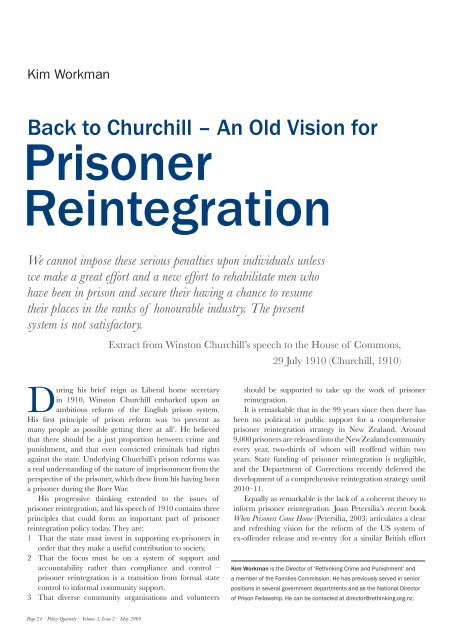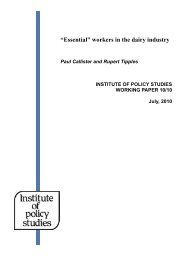Churchill - Institute for Governance and Policy Studies
Churchill - Institute for Governance and Policy Studies
Churchill - Institute for Governance and Policy Studies
- No tags were found...
You also want an ePaper? Increase the reach of your titles
YUMPU automatically turns print PDFs into web optimized ePapers that Google loves.
Kim WorkmanBack to <strong>Churchill</strong> – An Old Vision <strong>for</strong>PrisonerReintegrationWe cannot impose these serious penalties upon individuals unlesswe make a great ef<strong>for</strong>t <strong>and</strong> a new ef<strong>for</strong>t to rehabilitate men whohave been in prison <strong>and</strong> secure their having a chance to resumetheir places in the ranks of honourable industry. The presentsystem is not satisfactory.Extract from Winston <strong>Churchill</strong>’s speech to the House of Commons,29 July 1910 (<strong>Churchill</strong>, 1910)During his brief reign as Liberal home secretaryin 1910, Winston <strong>Churchill</strong> embarked upon anambitious re<strong>for</strong>m of the English prison system.His first principle of prison re<strong>for</strong>m was ‘to prevent asmany people as possible getting there at all’. He believedthat there should be a just proportion between crime <strong>and</strong>punishment, <strong>and</strong> that even convicted criminals had rightsagainst the state. Underlying <strong>Churchill</strong>’s prison re<strong>for</strong>ms wasa real underst<strong>and</strong>ing of the nature of imprisonment from theperspective of the prisoner, which drew from his having beena prisoner during the Boer War.His progressive thinking extended to the issues ofprisoner reintegration, <strong>and</strong> his speech of 1910 contains threeprinciples that could <strong>for</strong>m an important part of prisonerreintegration policy today. They are:1 That the state must invest in supporting ex-prisoners inorder that they make a useful contribution to society.2 That the focus must be on a system of support <strong>and</strong>accountability rather than compliance <strong>and</strong> control –prisoner reintegration is a transition from <strong>for</strong>mal statecontrol to in<strong>for</strong>mal community support.3 That diverse community organisations <strong>and</strong> volunteersshould be supported to take up the work of prisonerreintegration.It is remarkable that in the 99 years since then there hasbeen no political or public support <strong>for</strong> a comprehensiveprisoner reintegration strategy in New Zeal<strong>and</strong>. Around9,000 prisoners are released into the New Zeal<strong>and</strong> communityevery year, two-thirds of whom will reoffend within twoyears. State funding of prisoner reintegration is negligible,<strong>and</strong> the Department of Corrections recently deferred thedevelopment of a comprehensive reintegration strategy until2010–11.Equally as remarkable is the lack of a coherent theory toin<strong>for</strong>m prisoner reintegration. Joan Petersilia’s recent bookWhen Prisoners Come Home (Petersilia, 2003) articulates a clear<strong>and</strong> refreshing vision <strong>for</strong> the re<strong>for</strong>m of the US system ofex-offender release <strong>and</strong> re-entry (<strong>for</strong> a similar British ef<strong>for</strong>tKim Workman is the Director of ‘Rethinking Crime <strong>and</strong> Punishment’ <strong>and</strong>a member of the Families Commission. He has previously served in seniorpositions in several government departments <strong>and</strong> as the National Directorof Prison Fellowship. He can be contacted at director@rethinking.org.nz.Page 24 – <strong>Policy</strong> Quarterly – Volume 5, Issue 2 – May 2009
see Farrall, 2000). Nonetheless, these works of reintegrationtheory remain aberrant exceptions in a research field thatis dominated by descriptive <strong>and</strong> atheoretical evaluativeresearch. That is, we often ask ‘what works’ but too rarely ask‘how’ or ‘why?’ (Palmer, 1994).The ‘stick <strong>and</strong> carrot’ model – the odd coupleUntil around 1995 there had developed in New Zeal<strong>and</strong>a ‘mixed model’ culture within the Community Probationservice of the management of ex-prisoners. The prevailingassumption was that Community Probation should assertcontrol over ex-prisoners, <strong>and</strong> also provide opportunities<strong>for</strong> treatment. The provision of support to prisoners wouldmake the task more interesting, <strong>and</strong>, in those days, politicallyacceptable. The model had some inherent difficulties. Insummary:• The result, in other than the most experienced h<strong>and</strong>s,was ‘muddle’ (Dickey <strong>and</strong> Smith, 1998).• The history of crime control suggests that when bothtools (i.e. the therapeutic <strong>and</strong> the punitive) are available,the latter will almost always win out or at least underminethe <strong>for</strong>mer. More often than not, interventions premisedon a combination control–deficit modelend up ‘almost all stick <strong>and</strong> no carrot’.• Theoretically, control strategies encourageinstrumental compliance during thesupervisory period, while the treatmentstrategies are designed to help participantsinternalise new moral values. That is,the therapy or the job training is what isreally going to work, but without heavycoercion ex-prisoners will not show up <strong>for</strong>the treatment. This hypothesis has someempirical support (MacKenzie <strong>and</strong> Brame,2001). Persons coerced into drug treatmentprogrammes fare equally as well as thosewho enter voluntarily (Farabee, Prendergast <strong>and</strong> Anglin,1998).• However, while consistent coercion produces minimallevels of criminal behaviour, it also produces very lowlevels of pro-social behaviour (Colvin, Cullen <strong>and</strong> V<strong>and</strong>erVen, 2002, p.28). Punishment only trains a person whatnot to do. If one punishes behaviour, what is left toreplace it? – in the case of high-risk offenders, simplyother antisocial skills. This is why punishment scholarsstate that the most effective way to produce behaviouralchange is not to suppress ‘bad’ behaviour but to shape‘good’ behaviour.• The operant conditioning implied in the carrot <strong>and</strong> stickmetaphor confuses blind con<strong>for</strong>mity with responsiblebehaviour. Clark writes: ‘Compliance makes a poorfinal goal … Obedience is not a lofty goal. We can teachanimals to obey’ (Clark, 2000, p.42).• According to Taxman et al. (2002, p.8), offenders’ pastexperiences with law en<strong>for</strong>cement, supervision agencies<strong>and</strong> treatment providers ‘left them dubious about the realintentions of these agencies <strong>and</strong> staff. Any further ef<strong>for</strong>ts tofind fault, increase revocations, or speed a return to the justicesystem will only undermine the goals of reintegration.’The model has one other major deficit. It focusesalmost exclusively on the ex-prisoner as an individual. Ifreintegration is to be a meaningful concept, it implies morethan physically re-entering society. It should also includesome sort of ‘relational reintegration’ back into the moralcommunity.Winston <strong>Churchill</strong> understood well the dilemma ofcombining the stick <strong>and</strong> the carrot. In his day the police wereresponsible <strong>for</strong> providing post-release support. In his famousspeech, <strong>and</strong> with his tongue firmly in his cheek, he had thisto say:I have a great admiration <strong>for</strong> the way in which the policeconduct the business of police supervision of prisonerswho have been released on licence. It is not a bit true tosay they harry a man <strong>and</strong> hunt him down. At the sametime, it is a great impediment to a man to have to go <strong>and</strong>report himself repeatedly to the police, <strong>and</strong> to have thepolice coming repeatedly inquiring after him, in obtaininghis position in honest industry again.It wasn’t until 1999 that the departmentsought to conduct research which identifiedthe key needs of prisoners on release, <strong>and</strong>investigated how other jurisdictions dealt withreleased offendersCorrections <strong>and</strong> prisoner reintegration – risk, needs <strong>and</strong>responsivityUntil around 1995 the role of New Zeal<strong>and</strong> CommunityProbation Service in prisoner reintegration combined thefunctions of compliance <strong>and</strong> support. While the Prisoners’Aid <strong>and</strong> Rehabilitation Society (PARS) was funded by theDepartment of Corrections to provide services to prisoners,the emphasis was on the provision of welfare services toprisoners <strong>and</strong> their families: assistance with family visiting,provision of clothes <strong>and</strong> TV sets to prisoners, <strong>and</strong> limitedassistance with housing, employment, relational issues <strong>and</strong>financial matters. The PARS ‘halfway houses’ were verymuch places where semi-<strong>for</strong>mal supervision was applied.It wasn’t until 1999 that the department sought to conductresearch which identified the key needs of prisoners onrelease, <strong>and</strong> investigated how other jurisdictions dealt withreleased offenders (de Joux, 1999)The late 1990s saw responsibility <strong>for</strong> prisoner reintegrationshift from the Community Probation Service toward the PublicPrisons Service, as an extension of the developing Integrated<strong>Policy</strong> Quarterly – Volume 5, Issue 2 – May 2009 – Page 25
Back to <strong>Churchill</strong> – An Old Vision <strong>for</strong> Prisoner ReintegrationOffender Management System (IOMS). The prisoner in thecommunity was at that time, <strong>and</strong> still is, regarded as the passiverecipient of departmental support <strong>and</strong> services.In May 2004 the Minister of Corrections, Paul Swain,held a ministerial <strong>for</strong>um on offender reintegration, issuinga challenge <strong>for</strong> New Zeal<strong>and</strong> to be a ‘world leader inreintegration’. The framework he presented at that <strong>for</strong>umwas based on the following key ideas:No one wants the separation of prison <strong>and</strong>parole more urgently than do prisoners. ...Many would prefer to serve their full sentencein prison rather than be faced with high levelsof supervision.• Reintegration is the ‘cornerstone’ of the department’sapproach to integrated offender management.• The principles of risk, need <strong>and</strong> responsivity will tell thedepartment how to work with offenders, based on theirrisk of re-offending, their level of need, <strong>and</strong> responsivityfactors:Risk: by being able to identify those who are most at riskof further offending, <strong>and</strong> provide services to mitigateagainst that risk, the department can have a significantimpact.Need: services should be targeted at specific needs, <strong>and</strong> indealing with reintegrative needs the department mayhave to target a multiple range of needs <strong>and</strong> how thoseneeds relate to each other.Responsivity: there is no point in attempting to either delivera service to someone who doesn’t want it or deliveringit inappropriately without taking into account theirresponse. (Swain, 2004)The ‘needs-based’ approach to reintegration wasan extension of the department’s approach to in-prisonrehabilitation. By 2008 the department had exp<strong>and</strong>edprison-based reintegration services, with the intention ofassisting prisoners to re-enter their communities <strong>and</strong> thelabour market. Un<strong>for</strong>tunately, investment in additional inprisonreintegration staff was not matched by investment incommunity provision. A prisoner needs analysis ensured thatsome prisoners were released with a ‘reintegration plan’. Formost prisoners, tangible reintegrative support stops at theprison gate.The Community Probation Service – left holding the stickThe development of a prison-based reintegrative service leftthe Community Probation Service without a significant rolein prisoner reintegration, other than with parolees. Overthe last ten years they have shifted to a model of parolecompliance <strong>and</strong> control. Barry Matthews, chief executive ofthe Department of Corrections, made that clear in a recentpublic statement:Culture change was the main factor in improving parolemanagement, but took time, he said. ‘We have somestaff that still believe the role of a probation officer islike a social worker <strong>and</strong> that sentence compliance shouldtake a second step. We’ve been emphasising ... sentencecompliance is the No 1 issue in terms of public safety.’(Matthews, 2009)Underlying the ‘risk management’ approach isthe belief that released prisoners will respond bestto the constant threat of sanctions. Turning thatbelief into policy has led to a range of sentencemeasures, including electronic monitoring,intensive supervision (i.e. additional home<strong>and</strong> office visits), r<strong>and</strong>om drug testing, homeconfinement, extensive behaviour restrictions,strict curfews <strong>and</strong> exp<strong>and</strong>ed lengths of supervision.The basic idea is that tough community controlscan reduce recidivism by thwarting an offender’scriminal instincts (Gordon, 1991; Cullen, 2002).There is no evidence to support that. What evidencethere is tells us that:• Additional controls increase the probability that technicalviolations will be detected, leading to greater use ofimprisonment <strong>and</strong> higher taxpayer costs. Petersilia <strong>and</strong>Turner’s nine-state r<strong>and</strong>om-assignment evaluation foundno evidence that increased community surveillancedeterred offenders from committing crimes (Petersilia<strong>and</strong> Turner, 1993).• Prisons do not serve as an effective deterrent (Gendreau,Goggin <strong>and</strong> Cullen, 1999).• Power-coercive strategies are the least likely to promoteinternalisation <strong>and</strong> long-term change (Chin <strong>and</strong>Benne, 1976). Kelman (1958) discusses three means ofchanging behaviour: change via compliance, change viaidentification, <strong>and</strong> change via internalisation. Power <strong>and</strong>coercion may achieve instrumental compliance, Kelmansays, but is the least likely of the three methods to promote‘normative re-education’ <strong>and</strong> long-term trans<strong>for</strong>mationonce the ‘change agent’ has been removed (Bottoms,2000).• In MacKenzie <strong>and</strong> De Li’s rigorous study of intensivesupervision probation they write:The disappointing factor is the possibility that theoffenders may be influenced only as long as they arebeing supervised. …When probation is over, theseoffenders may return to their previous levels of criminalactivity because the deterrent effect of arrest maywear off when they are no longer under supervision(MacKenzie <strong>and</strong> De Li, 2002, pp.37-8).• Heavy-h<strong>and</strong>ed control tactics serve to undermine respect<strong>for</strong> the Probation Service (Tyler et. al, 1997). Paroleconditions that include prohibitions against associationwith criminal associates or entering licensed premises,both of which are impossible to en<strong>for</strong>ce, are often viewedPage 26 – <strong>Policy</strong> Quarterly – Volume 5, Issue 2 – May 2009
as evidence that the entire parole process is a joke.Persons returning from prison with few resources <strong>and</strong>little hope become defiant when they are faced with apile of sanctions (Sherman, 1993; Blomberg <strong>and</strong> Lucken,1994). Constant threats that are not backed up can leadto a <strong>for</strong>m of psychological inoculation (Colvin, Cullen<strong>and</strong> V<strong>and</strong>er Ven, 2002).• Ex-prisoners consider they have paid their debt to society:when they ‘get out’, they want to ‘be out’. Mobley <strong>and</strong>Terry (2002) write:No one wants the separation of prison <strong>and</strong> parole moreurgently than do prisoners. Any compromise or halfmeasure,any ‘hoops’ or hassles placedin their path, breeds resentment.Many would prefer to serve their fullsentence in prison rather than be facedwith high levels of supervision.• The traditional public view is thatimprisonment equates to punishment<strong>and</strong> control. Alternatives are there<strong>for</strong>eonly suitable when neither punishmentnor control are necessary. Parole cannotcompete with prison when it comes to ensuring compliance(Camp <strong>and</strong> Camp, 1997; Bottoms, 2000, p.93; Colvin,Cullen <strong>and</strong> V<strong>and</strong>er Ven, p.23).What next? Moving beyond risk <strong>and</strong> needs<strong>Churchill</strong> must have known something. In his 1910 speech heproposed another way:The proposal I make is that we should establish a newcentral agency of a semi official character, half officialmembers representing the authorities <strong>and</strong> half therepresentatives of all these prisoners’ aid societies.That would combine official power with what I thinkessential: that there shall be an individual study of everycase; that all convicts shall be distributed by the centralagency between different prisoners’ aid societies of all thedifferent denunciations, <strong>and</strong> all the different charitablesocieties; that the whole business of police supervisionshall be absolutely suspended <strong>and</strong> the whole systemof ticket of leave come to an end completely; <strong>and</strong> thatexcept in the case of refractory persons, a convict, whenhe leaves prison, will have nothing more to do with thepolice. They need not see them nor hear of them again,but will be dealt with entirely through the agency of thesesocieties, working under the central body, whose onlyobject will be to do the best <strong>for</strong> the convict.What would these societies do? How would they behaveto towards ex-prisoners? The clue we have is containedwithin <strong>Churchill</strong>’s speech when he proclaimed belief in thepossibility of redemption. He spoke ofan unfailing faith that there is a treasure if only you canfind it, in the heart of every man – these are the symbolswhich in the treatment of crime <strong>and</strong> criminals mark <strong>and</strong>measure the stored-up strength of a nation, <strong>and</strong> are thesign <strong>and</strong> proof of the living virtue in it.The Singaporean Prison Service has a prison posterwhich says: ‘We are trained to look <strong>for</strong> the spark, not just theflaw.’ <strong>Churchill</strong> would have supported that idea: the idea thatall humans have gifts, skills or strengths that if acknowledged<strong>and</strong> nurtured can make a difference. Success comes notthrough treating an offender as someone to be corralledlike a wild horse or understood through clinical analysis.It comes not from an image of an offender as a motor car,with defective parts, which ‘needs’ attention, but as a vibranthuman being who, if treated with dignity <strong>and</strong> respect, hasthe potential to change.‘released prisoners find themselves “in”but not “of” the larger society’ <strong>and</strong> ‘sufferfrom a presumption of moral contamination’‘Restorative reintegration’ – a strengths-based approach toprisoner reintegrationStrengths-based or restorative approaches focus on thepositive contribution the person can make rather than on theirdeficiencies. It is not a new idea in prisoner rehabilitation,but its re-emergence throughout the social service sector hasresulted in increased research <strong>and</strong> underst<strong>and</strong>ing about howthis approach could work with offenders.Targeting strengthsStrengths need to be assessed <strong>and</strong> ‘targeted’ in the sameway that risks <strong>and</strong> needs traditionally have been. To do soone simply asks: ‘How can this person make a useful <strong>and</strong>purposeful contribution to society?’ Jeremy Travis puts it thisway: ‘Offenders are seen as assets to be managed rather thanmerely liabilities to be supervised’ (Travis, 2000, p.7).The strengths narrative assumes that ex-prisoners arestigmatised persons, <strong>and</strong> that is what makes them likelyto re-offend. As Johnson writes, ‘released prisoners findthemselves “in” but not “of ” the larger society’ <strong>and</strong> ‘sufferfrom a presumption of moral contamination’ (Johnson,2002, p.319).The strengths-based narrative combats stigmatisation bydeploying a range of strategies. They include:• Providing opportunities <strong>for</strong> ex-prisoners to make amends,demonstrate their value <strong>and</strong> potential <strong>and</strong> make positivecontributions to their communities. The goal is to ‘deviseways of creating more helpers’ (Pearl <strong>and</strong> Riessman, 1965,p.88). These accomplishments lead to ‘a sense of hope,an orientation toward the future, <strong>and</strong> the willingness totake responsibility’.• Providing public recognition, including rituals ofcertification which symbolically ‘de-stigmatise’ thestigmatised person <strong>and</strong> send a message to the communitythat the offender is worthy of further support <strong>and</strong><strong>Policy</strong> Quarterly – Volume 5, Issue 2 – May 2009 – Page 27
Back to <strong>Churchill</strong> – An Old Vision <strong>for</strong> Prisoner Reintegrationinvestment (Bazemore, 1999). The offender is trans<strong>for</strong>medfrom a taker into a giver.• Devising situations in which ex-prisoners produce thingsthe community wants, such as gardens, graffiti-freeneighbourhoods, a less dangerous community, habitablehousing <strong>for</strong> the homeless (Dickey <strong>and</strong> Smith, 1998,p.35).• Active engagement in parenting provides a ‘stabilityzone’ <strong>for</strong> offenders which ‘softens the psychologicalimpact of confinement’ <strong>and</strong> may help reduce recidivism<strong>and</strong> ‘transmit pro-social attitudes to a future generation’(Toch, 1975; Lanier <strong>and</strong> Fisher, 1990, p.164). That mayinclude programmes specifically designed <strong>for</strong> prisoners<strong>and</strong> ex-prisoners.It is only in recent times that there has beenofficial recognition that whänau continueto be a key cultural institution <strong>for</strong> Mäori<strong>and</strong> are there<strong>for</strong>e a key (<strong>and</strong> potentiallyhighly effective) site of intervention <strong>and</strong>/ordevelopment.• Developing a role <strong>for</strong> ‘wounded healers’ or the‘professional ex-’, defined as a person who desists froma ‘deviant career’ by ‘replacing it’ with an occupation asa para-professional, lay therapist or counsellor (Brown,1991). Although it is impossible to measure the true extentof the ‘professional ex-’ phenomenon, Brown estimatedthat around three-quarters of the counsellors workingin the more than 10,000 substance abuse treatmentcentres in the United States are <strong>for</strong>mer substance abusersthemselves. Describing female ‘wounded healers’, Richiewrites:Most services that are successful in helping womenreintegrate into the community have hired (or areotherwise influenced by) women who have beensimilarly situated. The extent to which women havea peer <strong>and</strong>/or mentoring relationship with someonewhom they perceive is ‘like them’ is critical. (Richie,2001, p.385)• Encouraging mutual ef<strong>for</strong>ts at reconciliation, whereoffender <strong>and</strong> society work together to make amends –<strong>for</strong> hurtful crimes <strong>and</strong> hurtful punishments – <strong>and</strong> move<strong>for</strong>ward (Johnson, 2002, p.328).There is evidence that nurturing behaviour is inconsistentwith a criminal lifestyle. Sampson <strong>and</strong> Laub found that onetimeoffenders who were employed <strong>and</strong> took responsibility<strong>for</strong> providing <strong>for</strong> their spouses <strong>and</strong> children were significantlymore likely to desist from crime than those who made nosuch bonds. It is a common reason <strong>for</strong> desistance by gangmembers (Sampson <strong>and</strong> Laub, 1993). Roy Dunn, leader ofthe Notorious chapter of the Mongrel Mob, put it this way ina speech to the Prison Fellowship Conference in May 2008:At the end of the day, I have been thinking, what’s themeaning to life? There must be more to this, you know,there must be more to life. As a parent, a Rangatira,you have to look at all those angles, eh, <strong>and</strong> to me it wasabout – well, enough was enough. Keep going the way weare, we will live in the past <strong>and</strong> we will stay there. So, itwas all about time to change. That was my vision. WhenI came out of jail, I was looking <strong>for</strong> people in the societyto help direct <strong>and</strong> put me on that way, not <strong>for</strong> my journeybut <strong>for</strong> our kids <strong>and</strong> our whānau. In the old days, it wasabout our patch, we couldn’t see nothing else. Butnow, time’s changed. It’s time to build their future;not let them go down the paths we’ve been.The role of families <strong>and</strong> whänauThe strengths of youths, families <strong>and</strong> communitiesare the most commonly wasted resources inthe justice system. It is only in recent times thatthere has been official recognition that whänaucontinue to be a key cultural institution <strong>for</strong>Mäori <strong>and</strong> are there<strong>for</strong>e a key (<strong>and</strong> potentiallyhighly effective) site of intervention <strong>and</strong>/ordevelopment. The recent emphasis on whänauin social policy acknowledges that changes in thewell-being of individual Mäori can be broughtabout by focusing on the collective of whänau – somethingMäori have always known.The extent to which the state responds positively ornegatively to the concept of whänau or family has a significantpotential impact on our capacity to promote communitybasedprisoner reintegration. One recent promisingintervention is La Bodega de la Familia in New York City.Support is provided not to the individual under criminaljustice supervision, but rather to the person’s family – thepeople who will be supporting the individual when he or shereturns from prison. Initial evaluation research has been verypromising (Sullivan et al., 2002). Travis writes: ‘We shouldrecognize that a strong family can outlast any program <strong>and</strong>can work in ways that no one else can’ (Travis, 2003, p.4).The impact of strengths-based reintegrationIn 2003 Prison Fellowship, in partnership with the Departmentof Corrections, established a faith-based unit at RimutakaPrison. Described as a Christ-focused, community-centredenvironment, the programme provides <strong>for</strong> each prisoner tobe mentored by a community volunteer eight months be<strong>for</strong>erelease <strong>and</strong> <strong>for</strong> up to two years following. It is based on thebelief that reintegration starts on the first day of the sentence,<strong>and</strong> the programme includes the elements described aboveas restorative reintegration.The unit has yet to be <strong>for</strong>mally evaluated by the department.We know that one useful measure of the effectivenessPage 28 – <strong>Policy</strong> Quarterly – Volume 5, Issue 2 – May 2009
of a prison unit in rehabilitation is the level of prisonermisconduct. Gendreau <strong>and</strong> French have established thatprisoners released from those units with a low level of prisonincidents are more likely to achieve significant reductions inreoffending (French <strong>and</strong> Gendreau, 2006). As can be seen inFigure 1, covering the period 1 May 2007–30 April 2008,the faith unit (Unit Seven) fared well in comparison with theother residential 60-bed units at Rimutaka.Reintegration beyond the prison walls - h<strong>and</strong>ing it back to thecommunityWhat would restorative reintegration look like beyondthe prison walls? Maruna (2006) considers there are fourelements:Restorative reintegration is community-ledWhereas reintegration is typically characterised by aninsular, professionals-driven focus on the needs <strong>and</strong> risks ofoffenders, restorative reintegration needs to draw on <strong>and</strong>support naturally occurring community processes throughwhich in<strong>for</strong>mal support <strong>and</strong> controls traditionally takeplace (Farrall, 2004). Citizens, not professionals, would bethe primary agents of reintegration. Circles of support <strong>and</strong>community-led mentoring are key elements of a communityledprocess (Petrunik, 2002). Ef<strong>for</strong>ts by groups such as PrisonFellowship, PARS, Pillars <strong>and</strong> other organisations to offerdirect support <strong>and</strong> assistance to the families of offendersbe<strong>for</strong>e <strong>and</strong> after incarceration is also central to restorativereintegration (Sullivan et al., 2002). It is these family members(<strong>and</strong> not the over-worked probation officer with an overstretchedcaseload) who will be counted on to do the realwork of aiding <strong>and</strong> befriending the ex-prisoner upon release(Bobbitt <strong>and</strong> Nelson, 2004).Restorative reintegration is reparation-basedPeacemaking needs to begin almost immediately in anyrestorative framework (Marshall, 1999). The fact that somany victims are still angry, afraid or punitive toward theirassailants five to ten years after the event <strong>and</strong> at the pointof the prisoner’s release shows just how much more workneeds to be done in this regard in terms of healing the painof the criminal event, apologising <strong>and</strong> making amends <strong>for</strong>these acts.Central to the restorative model is the notion of ‘makinggood’, or ‘earned redemption’ (Maruna, 2001; Brazemore<strong>and</strong> Erbe, 2004). Traditionally, this is won by actively makingpositive contributions to one’s community in a reparativefashion. This abstract ‘wider community’ is often theprimary victim of many of the crimes in our justice system.In civic community service work, individuals are offered anopportunity to volunteer their talents on projects meant tomeet community needs, build community capacity <strong>and</strong> repairthe harm caused by crime. They take on leadership roles withinthese projects <strong>and</strong> often work side by side with volunteers fromthe wider community who are not involved in the criminaljustice system. Again, the community would lead this process.Restorative reintegration should be symbolically richNew Zeal<strong>and</strong>ers make quite an impressive show or ritual ofpunishment – from the drama of the courtroom to descendinginto the cells, to prisoner uni<strong>for</strong>ms, the barred windows <strong>and</strong> apreference <strong>for</strong> ‘boot camps’ <strong>and</strong> ‘three strikes’. As a society wehave become masters of what are called status degradationceremonies (Garfinkel, 1956). If we are going to ritualise theprocess of exile, we need to do the same <strong>for</strong> the return. Anumber of theorists have started to write about what ‘statuselevation ceremonies’, or ‘reintegration rituals’, might looklike (Braithwaite <strong>and</strong> Mug<strong>for</strong>d, 1994; Maruna, 2001).Restorative reintegration needs to eventually involve wiping theslate cleanPerhaps the strongest <strong>for</strong>m of symbolic de-labelling an offendercould receive from the state is the chance to officially wipethe slate clean <strong>and</strong> literally alter his or her past as recognitionof these <strong>for</strong>ms of restitution <strong>and</strong> social contribution. Thissort of permission to legally move on from the stigma ofFigure 1504535302520151050U4 U5 U6 U7 U8WeaponsPornCashCellphone <strong>and</strong> ChargesTattooing EquipmentOthersDrugs & Alcohol<strong>Policy</strong> Quarterly – Volume 5, Issue 2 – May 2009 – Page 29
Back to <strong>Churchill</strong> – An Old Vision <strong>for</strong> Prisoner Reintegrationone’s past is a key component of the amnesty process that hasbeen central to peace <strong>and</strong> reconciliation processes worldwide.More use could be made of this important last step in thereintegration process <strong>for</strong> ordinary offenders.The role of the community<strong>Churchill</strong> realised that to shift responsibility <strong>for</strong> prisonerreintegration to the community there would need to beresources to accompany it:The Chancellor of the Exchequer has been good enoughto assign me £7,500 a year <strong>for</strong> the development <strong>and</strong>strengthening of the methods by which we are to enableprisoners, on release from penal servitude, to have a fairchance of taking their place in the ordinary life of thecountry.The emerging view is that the state does not have a rolein reintegrating ex-prisoners. Criminal justice professionalscannot reintegrate anyone into the community, regardless oftheir training. Ex-prisoners can reintegrate themselves <strong>and</strong>communities can reintegrate ex-offenders. The most the statecan do is to facilitate <strong>and</strong> support the community in its ef<strong>for</strong>ts(McNeill, 2006). Reintegration happens in the community, bythe community <strong>and</strong> <strong>for</strong> the community.As the reach of criminal justice <strong>and</strong> social services exp<strong>and</strong>,the impact is to weaken historically stronger community nets<strong>and</strong> inadvertently undercut the role <strong>and</strong> responsibility ofcitizens, neighbourhood institutions <strong>and</strong> community groupsin socialisation <strong>and</strong> in<strong>for</strong>mal sanctioning (Braithwaite, 1994;McKnight, 1995). As Clear <strong>and</strong> Karp (1999, p.38) observe:When agents of the state become the key problemsolvers, they might be filling a void in community; butjust as in interpersonal relationships, so in communityfunctioning, once a function is being per<strong>for</strong>med by oneparty it becomes unnecessary <strong>for</strong> another to take it on ...parents expect police or schools to control their children;neighbors expect police to prevent late night noise frompeople on their street; <strong>and</strong> citizens expect the courts toresolve disputes ... in<strong>for</strong>mal control systems may atrophylike dormant muscles, <strong>and</strong> citizens may come to see the<strong>for</strong>mal system as existing to mediate all conflicts.From criminal justice to social developmentThe recent work of the Ministry of Social Development instrengthening families <strong>and</strong> communities suggests that if thereis to be state support <strong>for</strong> ex-prisoners <strong>and</strong> their whänau/families, it would be most appropriately located withinFamily <strong>and</strong> Community Services, in the Ministry of SocialDevelopment. The excellent work it is doing in strengtheningfamilies <strong>and</strong> communities, <strong>and</strong> supporting community groupsin such areas as family violence prevention, positive parenting<strong>and</strong> after-school activity, gives it an entrée into <strong>and</strong> relationshipwith community organisations. It has the capability to engageeffectively with ‘hard to reach’ families, including the families<strong>and</strong> whänau of ex-prisoners. It is a service familiar with thestrengths-based approach, <strong>and</strong> underst<strong>and</strong>s the importanceof building community resilience <strong>and</strong> social cohesion. Mostimportantly, it underst<strong>and</strong>s that its role is not to deliver thoseservices itself, but to build community capacity <strong>and</strong> capabilityin order <strong>for</strong> that to happen.Agreement on how the state <strong>and</strong> the community shouldwork together to support ex-prisoners <strong>and</strong> their whänau/families will not depend solely on the extent to whichstakeholders can reach agreement. The future of effectiveprisoner reintegration lies in the government’s willingness tomove beyond the existing preference to control ex-prisoners,on one h<strong>and</strong>, <strong>and</strong> on the other to respond to their perceivedindividual needs. It lies not in an obsession with managerialism<strong>and</strong> the culture of control. Instead, it must be based on a vision<strong>for</strong> prisoner trans<strong>for</strong>mation that has at its heart concern <strong>for</strong>the social advancement of all New Zeal<strong>and</strong>ers.That was <strong>Churchill</strong>’s vision.ReferencesBazemore, G. (1999) ‘After shaming, whitherreintegration: restorative justice <strong>and</strong>relational rehabilitation’, in G. Bazemore<strong>and</strong> L. Walgrave (eds), Restorative JuvenileJustice: repairing the harm of youth crime,Monsey, NY: Criminal Justice PressBazemore, G. <strong>and</strong> C. Erbe (2004)‘Reintegration <strong>and</strong> restorative justice:toward a theory <strong>and</strong> practice of in<strong>for</strong>malsocial control <strong>and</strong> support’, in S. Maruna<strong>and</strong> R. Immarigeon (eds), After Crime<strong>and</strong> Punishment: pathways to offenderreintegration, Cullompton: WillanBlomberg, T. <strong>and</strong> K. Lucken (1994) ‘Stackingthe deck by piling up sanctions: isintermediate punishment destined to fail?’,Howard Journal, 33 (1), pp.62-80Bobbitt, M. <strong>and</strong> M. Nelson (2004) The FrontLine: building programs that recognizefamilies’ role in reentry, New York: Vera<strong>Institute</strong> of JusticeBottoms, A.E. (2000) ‘Compliance <strong>and</strong>community penalties’, in A. Bottoms, L.Gelsthorpe <strong>and</strong> S. Rex (eds), CommunityPenalties: change <strong>and</strong> challenges,Cullompton: WillanBraithwaite G.J. (1994) ‘Thinking harder aboutdemocratizing social control’, in C. Alder<strong>and</strong> J. Wundersitz (eds), Family GroupConferencing in Juvenile Justice: the way<strong>for</strong>ward of misplaced optimism?, Canberra:Australian <strong>Institute</strong> of CriminologyBraithwaite, J. <strong>and</strong> S. Mug<strong>for</strong>d (1994)‘Conditions of successful reintegrationceremonies: dealing with juvenileoffenders’, British Journal of Criminology,34, pp.139-71Brown, D.J. (1991) ‘The professional ex-: analternative <strong>for</strong> exiting the deviant career’,Sociological Quarterly, 32, pp.219-30Camp, C.G. <strong>and</strong> G.M. Camp (1997) TheCorrections Yearbook, South Salem, NY:Criminal Justice <strong>Institute</strong>Chin, R. <strong>and</strong> K.D. Benne (1976) ‘Generalstrategies <strong>for</strong> effecting changes in humansystems’, in W.G. Bennis et al. (eds), ThePlanning of Change, 3rd edition, New York:Page 30 – <strong>Policy</strong> Quarterly – Volume 5, Issue 2 – May 2009
Rinehart <strong>and</strong> Winston<strong>Churchill</strong> (1910) Speech to the House ofCommons, Hansard, 20 Jul 1910,col.1354Clark, M.D. (2000) ‘The juvenile drug courtjudge <strong>and</strong> lawyer: four common mistakes intreating drug court adolescents’, Juvenile<strong>and</strong> Family Court Journal, 51 (4)Clear, T. <strong>and</strong> D. Karp (1999) The CommunityJustice Ideals: preventing crime <strong>and</strong>achieving justice, New York: Western PressColvin, M., F.T. Cullen <strong>and</strong> T.M. V<strong>and</strong>er Ven(2002) ‘Coercion, social support, <strong>and</strong>crime: an emerging theoretical consensus’,Criminology, 40, pp.19-42Cullen, F.T. (2002) ‘Rehabilitation <strong>and</strong>treatment programs’, in J.Q. Wilson <strong>and</strong> J.Petersilia (eds), Crime: public policies <strong>for</strong>crime control, Oakl<strong>and</strong>, CA: <strong>Institute</strong> <strong>for</strong>Contemporary <strong>Studies</strong>Dickey, W.J. <strong>and</strong> M.E. Smith (1998) DangerousOpportunity: five futures <strong>for</strong> communitycorrections. The report from the focusgroup, Washington, DC: US Department ofJustice, Office of Justice ProgramsFarabee, D., M. Prendergast <strong>and</strong> M.D. Anglin(1998) ‘The effectiveness of coercedtreatment <strong>for</strong> drug-abusing offenders’,Federal Probation, 62 (1), pp.3-10Farrall, S. (ed.) (2000) The Termination ofCriminal Careers, Burlington, VT: AshgateFarrall, S. (2004) ‘Social capital <strong>and</strong> offenderreintegration: making probation desistancefocused’, in S. Maruna <strong>and</strong> R. Immarigeon(eds), After Crime <strong>and</strong> Punishment:pathways to offender reintegration,Cullompton: WillanFrench, S.A. <strong>and</strong> P. Gendreau (2006) ‘Reducingprison misconducts: what works!’, ClinicalJustice <strong>and</strong> Behaviour, 33 (2), April,pp.185-218Garfinkel, H. (1956) ‘Conditions of successfuldegradation ceremonies’, American Journalof Sociology, 61, pp.420-24Gendreau, P., C. Goggin <strong>and</strong> F.T. Cullen(1999) The Effects of Prison Sentenceson Recidivism, report to the CorrectionsResearch <strong>and</strong> Development <strong>and</strong> Aboriginal<strong>Policy</strong> Branch, Ottawa: Solicitor General ofCanadaGordon, D. (1991) The Justice Juggernaut:fighting street crime, controlling citizens,New Brunswick, NJ: Rutgers UniversityPressJohnson, R. (2002) Hard Time, 3rd edition,Belmont, CA: Wadsworthde Joux, V. (2009) Post-order Support:offenders’ needs <strong>and</strong> models of response,Wellington: Department of CorrectionsKelman, H.C. (1958) ‘Compliance,identification <strong>and</strong> internalization: threeprocesses of opinion change’, Journal ofConflict Resolution, 2, pp.51-60Lanier, C.S. <strong>and</strong> G. Fisher (1990) ‘A prisoners’parenting center (PPC): a promisingresource strategy <strong>for</strong> incarcerated fathers’,Journal of Correctional Education, 41MacKenzie, D.L. <strong>and</strong> R. Brame (2001)‘Community supervision, prosocialactivities, <strong>and</strong> recidivism’, JusticeQuarterly, 18 (2), pp.429-48MacKenzie, D.L. <strong>and</strong> S. De Li (2002) ‘Theimpact of <strong>for</strong>mal <strong>and</strong> in<strong>for</strong>mal socialcontrols on the criminal activities ofprobationers’, Journal of Research in Crime<strong>and</strong> Delinquency, 39, pp.243-76McKnight, J. (1995) The Careless Society:community <strong>and</strong> its counterfeits, New York:Basic BooksMcNeill, F. (2006) ‘A desistance paradigm <strong>for</strong>offender management’, Criminology <strong>and</strong>Criminal Justice, 6, pp.39-62Maruna, S. (2001) Making Good: how exconvictsre<strong>for</strong>m <strong>and</strong> rebuild their lives,Washington, DC: American PsychologicalAssociation BooksMaruna, S. (2006) ‘Who owns resettlement?Towards restorative re-integration’, BritishJournal of Community Justice, 4 (2), pp.23-33Marshall, T.E. (1999) Restorative Justice: anoverview, London: Home Office ResearchDevelopment <strong>and</strong> Statistics DirectorateMatthews, B. (2009) Dominion Post, 21FebruaryMobley, A. <strong>and</strong> C. Terry (2002) ‘Dignity,resistance <strong>and</strong> re-entry: a convictperspective’, unpublished manuscriptPalmer, T. (1994) A Profile of CorrectionalEffectiveness <strong>and</strong> New Directions <strong>for</strong>Research, Albany, NY: Suny PressPearl, A. <strong>and</strong> F. Riessman (1965) New Careers<strong>for</strong> the Poor: the nonprofessional in humanservice, New York: The Free PressPetersilia, J. (2003) When Prisoners ComeHome: parole <strong>and</strong> prisoner reentry, Ox<strong>for</strong>d:Ox<strong>for</strong>d University PressPetersilia, J. <strong>and</strong> S. Turner (1993) ‘Intensiveprobation <strong>and</strong> parole’, in M. Tonry (ed.),Justice: annual review of research, 19,Chicago: Chicago University PressPetrunik, M.G. (2002) ‘Managing unacceptablerisk: sex offenders, community response,<strong>and</strong> social policy in the United States <strong>and</strong>Canada’, International Journal of OffenderTherapy <strong>and</strong> Comparative Criminology, 46(4), pp.483-511Richie, B. (2001) ‘Challenges incarceratedwomen face as they return to theircommunities: findings from life historyinterviews’, Crime <strong>and</strong> Delinquency, 47Sampson, R.J. <strong>and</strong> J. Laub (1993) Crime inthe Making: pathways <strong>and</strong> turning pointsthrough life, Cambridge, MA: HarvardUniversity PressSherman, L.W. (1993) ‘Defiance, deterrence,<strong>and</strong> irrelevance: a theory of the criminalsanction’, Journal of Research in Crime<strong>and</strong> Delinquency, 30, pp.445-73Sullivan, E., M. Mino, K. Nelson <strong>and</strong> J.Pope (2002), Families as a Resource inRecovery from Drug Abuse: an evaluationof La Bodega de la Familia, New York: Vera<strong>Institute</strong> of JusticeSwain, P. (2004) Presentation at theDepartment of Corrections community<strong>for</strong>um on offender reintegrationTaxman, F.S., D. Young, J.N. Byrne, A.Holsinger <strong>and</strong> D. Anspach (2002) FromPrison Safety to Public Safety: innovationson offender reentry, College Park:University of Maryl<strong>and</strong>Toch, H. (1975) Men in Crisis: humanbreakdowns in prisons, Chicago: AldineTravis, J. (2000) But They All Come Back:rethinking prisoner reentry. Researchin brief – sentencing <strong>and</strong> corrections:issues <strong>for</strong> the 21st century, NCJ 181413,Washington, DC: US Department ofJustice, National <strong>Institute</strong> of JusticeTravis, J. (2003) In Thinking about ‘WhatWorks’, What Works Best, Urban InstitueJustice <strong>Policy</strong> CentreTyler, T.R., R.J. Boeckmann, H.J. Smith <strong>and</strong>Y.J. Huo (1997) Social Justice in a DiverseSociety, Denver: Westview Press<strong>Policy</strong> Quarterly – Volume 5, Issue 2 – May 2009 – Page 31













